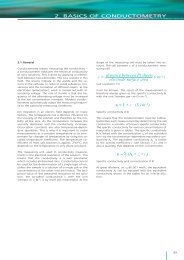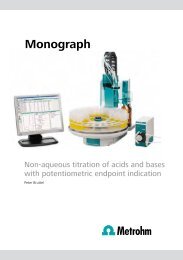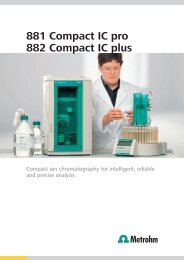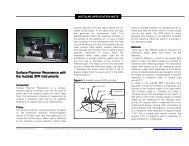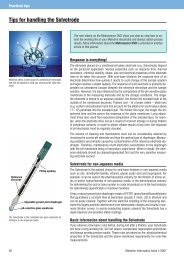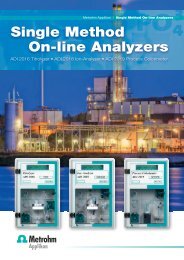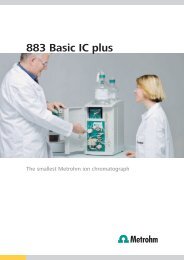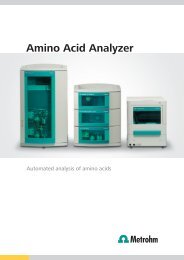What is the theoretical background of potentiometry? - Metrohm
What is the theoretical background of potentiometry? - Metrohm
What is the theoretical background of potentiometry? - Metrohm
You also want an ePaper? Increase the reach of your titles
YUMPU automatically turns print PDFs into web optimized ePapers that Google loves.
1. BASICS OF POTENTIOMETRY1.3. Measuring electrodes1.3.1. pH glass electrodesHow does a pH glass electrode work?The glass membrane <strong>of</strong> a pH glass electrode cons<strong>is</strong>ts<strong>of</strong> a silicate framework containing lithium ions. Whena glass surface <strong>is</strong> immersed in an aqueous solution<strong>the</strong>n a thin solvated layer (gel layer) <strong>is</strong> formed on <strong>the</strong>glass surface in which <strong>the</strong> glass structure <strong>is</strong> s<strong>of</strong>ter.Th<strong>is</strong> applies to both <strong>the</strong> outside and inside <strong>of</strong> <strong>the</strong>glass membrane. As <strong>the</strong> proton concentration in <strong>the</strong>inner buffer <strong>of</strong> <strong>the</strong> electrode <strong>is</strong> constant (pH = 7), astationary condition <strong>is</strong> establ<strong>is</strong>hed on <strong>the</strong> inner surface<strong>of</strong> <strong>the</strong> glass membrane. In contrast, if <strong>the</strong> protonconcentration in <strong>the</strong> measuring solution changes<strong>the</strong>n ion exchange will occur in <strong>the</strong> outer solvatedlayer and cause an alteration in <strong>the</strong> potential at <strong>the</strong>glass membrane. Only when th<strong>is</strong> ion exchange hasachieved a stable condition will <strong>the</strong> potential <strong>of</strong> <strong>the</strong>glass electrode also be constant. Th<strong>is</strong> means that <strong>the</strong>response time <strong>of</strong> a glass electrode always depends on<strong>the</strong> thickness <strong>of</strong> <strong>the</strong> solvated layer. Continuous contactwith aqueous solutions causes <strong>the</strong> thickness <strong>of</strong><strong>the</strong> solvated layer to increase continuously – even ifonly very slowly – which results in longer responsetimes. Th<strong>is</strong> <strong>is</strong> why conditioning <strong>the</strong> electrode in a suitableelectrolyte <strong>is</strong> absolutely necessary to ensure aninitial solvated layer condition that <strong>is</strong> as stationary aspossible so that results can be obtained that are as reproducibleas possible.Figure 3:The silicate skeleton <strong>of</strong> <strong>the</strong> glass membrane contains lithium ions,among o<strong>the</strong>r things. During <strong>the</strong> formation <strong>of</strong> <strong>the</strong> solvated layerat <strong>the</strong> glass surface <strong>the</strong>se are partly replaced by protons. If <strong>the</strong> concentration<strong>of</strong> <strong>the</strong> protons in <strong>the</strong> solution changes <strong>the</strong>n a new stationarycondition must again be achieved in <strong>the</strong> solvated layer; th<strong>is</strong>results in a change in potential at <strong>the</strong> glass membrane.Why are <strong>the</strong>re different types <strong>of</strong> glass forpH electrodes?Different demands are placed on a pH glass electrodedepending on <strong>the</strong> particular application. Various propertiessuch as response time, <strong>the</strong>rmal res<strong>is</strong>tance,chemical stability, shape, size and electrical propertiesmust all be taken into account in order to have anoptimal electrode available to solve each problem. Inorder to be able to do justice to <strong>the</strong> numerous applications,different glasses are available with <strong>the</strong> followingproperties:Table 1: Overview <strong>of</strong> <strong>the</strong> different electrode membrane glasses used by <strong>Metrohm</strong> LtdApplicationpH rangeTemperature rangecontinuousshort-termMembranesurfaceSpecial featuresMembraneres<strong>is</strong>tance(MΩ)U glass(green)0...140...80 °C0...100 °CElectrodeswith largemembranesurfaceFor stronglyalkaline solutions,long-termmeasurementsand measurementsat hightemperatures150...500T glass(blue)0...140...80 °CElectrodes withmedium to largemembranesurface(mini-electrodes)Measurementsin non-aqueoussample solutions40...600M glass(colorless)0...140...60 °CElectrodeswith smallmembranesurface(microelectrodes)Measurementsinsmall-volumesamples300...700Aquatrode glass(colorless)0...130...80 °CLarge surfacesResponds veryquickly, soparticularly suitablefor measurementsin ion-deficient orweakly bufferedsolutions80...200E glass(yellow)0...130...80 °CElectrodes withmedium to largemembranesurfaceQuick response,excellent stabilityin continuoususe50...30076
1. BASICS OF POTENTIOMETRYconditions (z = 1, T = 298.15 K) <strong>the</strong> Nernst potentialU N <strong>is</strong> equal to 59.16 mV. For o<strong>the</strong>r temperatures it canbe corrected in <strong>the</strong> Nernst equation by using Table 2.Modern pH meters automatically take <strong>the</strong> temperaturedependency <strong>of</strong> <strong>the</strong> Nernst potential into accountif a temperature sensor <strong>is</strong> connected. In principle,within <strong>the</strong> context <strong>of</strong> GLP/ISO recording and documentation<strong>of</strong> <strong>the</strong> temperature <strong>is</strong> required for all measurements.However, it must be remembered that a pH meter canonly correct <strong>the</strong> temperature behavior <strong>of</strong> <strong>the</strong> electrodeand never that <strong>of</strong> <strong>the</strong> solution to be measured.For correct pH measurements it <strong>is</strong> essential that <strong>the</strong>pH <strong>is</strong> measured at <strong>the</strong> temperature at which <strong>the</strong>sample was taken. For example, sodium hydroxidec(NaOH) = 0.001 mol/L at 0 °C has a pH <strong>of</strong> 11.94, at50 °C it <strong>is</strong> pH = 10.26 and only at 25 °C <strong>is</strong> it pH =11.00. Th<strong>is</strong> change in pH <strong>is</strong> caused by <strong>the</strong> dependency<strong>of</strong> <strong>the</strong> ionic product <strong>of</strong> water on <strong>the</strong> temperature.In some conventional electrodes <strong>the</strong> temperature sensor<strong>is</strong> not located in <strong>the</strong> immediate vicinity <strong>of</strong> <strong>the</strong>membrane, i.e. in <strong>the</strong> electrode foot. Th<strong>is</strong> means thatit cannot measure <strong>the</strong> temperature <strong>of</strong> <strong>the</strong> solutioncorrectly and that <strong>the</strong> pH compensation will be incorrectas <strong>the</strong> temperature and pH are not measuredat <strong>the</strong> same location. In modern pH electrodes <strong>the</strong>temperature sensor should be located within <strong>the</strong>electrode in <strong>the</strong> immediate vicinity <strong>of</strong> <strong>the</strong> glass membrane.Th<strong>is</strong> <strong>is</strong> <strong>the</strong> only way in which an accurate pHmeasurement <strong>is</strong> possible. If <strong>the</strong> sensor <strong>is</strong> located outside<strong>the</strong> membrane <strong>the</strong>n problems when cleaning <strong>the</strong>electrode could easily occur. The temperature sensorshould also sat<strong>is</strong>fy <strong>the</strong> requirements <strong>of</strong> DIN/IEC 751for class B temperature sensors at <strong>the</strong> very minimum.Figure 6:Iso<strong>the</strong>rmal intersection pointHow to store a pH glass electrode?The swelling <strong>of</strong> <strong>the</strong> glass surface <strong>is</strong> ind<strong>is</strong>pensable for<strong>the</strong> use <strong>of</strong> glass as membrane for pH glass electrodes;without th<strong>is</strong> solvated layer, no pH measurementwould be possible. Glasses for pH glass electrodes areoptimized in such a way that only protons can penetrateinto <strong>the</strong> glass membrane. However, because <strong>of</strong><strong>the</strong> very slow but steady swelling <strong>of</strong> <strong>the</strong> glass, it <strong>is</strong>unavoidable that also o<strong>the</strong>r ions penetrate into <strong>the</strong>glass, e.g. sodium and potassium ions. At higher concentrations,<strong>the</strong>se lead to <strong>the</strong> so-called alkali error <strong>of</strong><strong>the</strong> glass electrode. Th<strong>is</strong> means that <strong>the</strong> measuredvalue <strong>is</strong> falsified at comparatively low proton concentrations.If <strong>the</strong> glass electrode <strong>is</strong> stored for a very longtime in a strong solution <strong>of</strong> potassium or sodium, th<strong>is</strong>leads to prolonged response times <strong>of</strong> <strong>the</strong> glass membranesince <strong>the</strong> protons must expulse <strong>the</strong> «addedions» from <strong>the</strong> solvated layer.Table 2:Dependency <strong>of</strong> <strong>the</strong> Nernst potential U N on <strong>the</strong> temperatureTemperature T Slope U N Temperature T Slope U N(°C) (mV) (°C) (mV)0 54.20 50 64.125 55.19 55 65.1110 56.18 60 66.1015 57.17 65 67.0920 58.16 70 68.0825 59.16 75 69.0730 60.15 80 70.0735 61.14 85 71.0637 61.54 90 72.0540 62.13 95 73.0445 63.12 100 74.03Figure 7:Cross-section <strong>of</strong> a pH glass membrane. If several kinds <strong>of</strong> cationsare present in <strong>the</strong> measuring solution, <strong>the</strong>se compete for <strong>the</strong> freespaces in <strong>the</strong> solvated layer. Especially potassium and sodium canpenetrate into <strong>the</strong> glass membrane and prolong <strong>the</strong> response time78
One <strong>of</strong> <strong>the</strong> most used electrolytes for pH measurement<strong>is</strong> c(KCl) = 3 mol/L, since <strong>the</strong> aequitransferentKCl causes only a very small diffusion potential at <strong>the</strong>diaphragm and <strong>is</strong> also economical. Normally a combinedpH glass electrode <strong>is</strong> stored in c(KCl) = 3 mol/Lonly for th<strong>is</strong> reason, as one wants to have it ready forimmediate use without conditioning <strong>the</strong> diaphragm.However, on a long-term bas<strong>is</strong> <strong>the</strong> storage in KClaffects <strong>the</strong> glass, since it leads to ever longer responsetimes. For <strong>the</strong> membrane glass, storage in d<strong>is</strong>tilledwater would be optimal, but <strong>the</strong>n <strong>the</strong> diaphragmwould have to be conditioned for several hours. Thepatented storage solution for combined pH glasselectrodes (6.2323.000) solves exactly th<strong>is</strong> problem. Ifa combined pH glass electrode <strong>is</strong> kept in th<strong>is</strong> solution,<strong>the</strong> glass membrane remains unchanged regardingresponse time and alkali error. Moreover, if one usesc(KCl) = 3 mol/L as <strong>the</strong> reference electrolyte, <strong>the</strong> optimizedcomposition <strong>of</strong> <strong>the</strong> storage solution keeps <strong>the</strong>pH glass electrode ready for measurement. Conditioningbefore <strong>the</strong> measurement <strong>is</strong> not necessary, nomatter for how long <strong>the</strong> electrode has been stored.Figure 8:pH measurement in c(NaHCO 3 ) = 0.05 mmol/L. A glass <strong>of</strong> <strong>the</strong>Aquatrode stored in <strong>the</strong> storage solution shows a substantiallyshorter response time than an electrode glass <strong>of</strong> <strong>the</strong> same typestored during <strong>the</strong> same period in KCl.Table 3: The correct storage <strong>of</strong> pH glass electrodesElectrode resp. reference electrolyteSeparate pH glass electrodeCombined pH glass electrode with c(KCl) = 3 mol/LCombined pH glass electrode with ano<strong>the</strong>rreference electrolyte (Idrolyte, Porolyte, non aqueous)Gel (spearhead electrode)StorageD<strong>is</strong>tilled water6.2323.000 storage solutionIn <strong>the</strong> respective reference electrolytePorolyte or c(KCl) = 3 mol/LTroubleshootingThe cause <strong>of</strong> most problems <strong>is</strong> not to be found in <strong>the</strong>measuring electrode and its glass membrane, butra<strong>the</strong>r in <strong>the</strong> reference electrode, as much more criticaldiaphragm problems can occur <strong>the</strong>re. To avoid incorrectmeasurements and to increase <strong>the</strong> workinglife, attention must still be paid to <strong>the</strong> following possiblesources <strong>of</strong> error:79
1. BASICS OF POTENTIOMETRYTable 4: Possible sources <strong>of</strong> error and <strong>the</strong>ir remedies for pH glass electrodesSource <strong>of</strong> errorHF-containing solutionsHigh pH value andhigh alkali contentHigh temperaturesMeasurements atlow temperaturesDry storageReaction <strong>of</strong> a solutioncomponent with <strong>the</strong> glassEffectsEtching and d<strong>is</strong>solution<strong>of</strong> <strong>the</strong> glass membrane ➝corrosion potential during<strong>the</strong> measurement/shortworking lifeIncreased alkali error ➝pH too lowRapid r<strong>is</strong>e in membraneres<strong>is</strong>tance by aging ➝increased polarizabilityand driftHigh membraneres<strong>is</strong>tance ➝polarization effectsZero point driftSlow response, zero pointshift, slope reductionCleaningStore in waterovernightAlternativesUse <strong>of</strong> <strong>the</strong> Sb electrodeUse <strong>of</strong> electrodeswith U glassUse <strong>of</strong> electrodeswith U glassUse <strong>of</strong> electrodes withT glass and Idrolyteas reference electrolyteStore in storage solution6.2323.000 orreference electrolyteTry o<strong>the</strong>r glass typesNon-aqueous mediaDeposition <strong>of</strong> solids onmembrane surfaceReduced sensitivitySlow response, zero pointshift, slope reductionStore in waterSolventor strong acidsT glass/non-aqueouselectrolyte solutionElectrostatic chargingDeposition <strong>of</strong> proteins onmembrane surfaceSlow responseSlow response, zero pointshift, slope reductionNo dab-drying <strong>of</strong><strong>the</strong> electrode5% pepsin in0.1 mol/L HClGrounding <strong>of</strong>measuring instrumentPossible sources <strong>of</strong> error and care information for diaphragm problems are given in Section 1.4. for reference electrodes.1.3.2. Metal electrodesHow does a metal electrode work?Metal electrodes have an exposed metal surface. Ifions <strong>of</strong> th<strong>is</strong> metal are contained in <strong>the</strong> sample solution<strong>the</strong>n an equilibrium <strong>is</strong> formed at <strong>the</strong> metal surfacethat depends on <strong>the</strong> concentration <strong>of</strong> <strong>the</strong> metalions in <strong>the</strong> solution (see «Theory <strong>of</strong> <strong>the</strong> electricaldouble layer» in electrochem<strong>is</strong>try textbooks). Metalions are accepted by <strong>the</strong> metal surface and simultaneouslyreleased into <strong>the</strong> solution.(8)Me Me n+ +n * e – E 0 =...Th<strong>is</strong> concentration-dependent equilibrium <strong>is</strong> characterizedby a corresponding potential E 0 (Galvani potential),e.g. <strong>the</strong> Ag/Ag + equilibrium at a silver surfacehas a value <strong>of</strong> E 0 = 0.7999 V (25°C). If <strong>the</strong> samplesolution does not contain any ions <strong>of</strong> <strong>the</strong> correspondingmetal <strong>the</strong>n metal electrodes can still form aGalvani potential if a redox reaction occurs in <strong>the</strong>sample solution.(9)S ox + n * e –S redThe electrode surface <strong>is</strong> inert to <strong>the</strong> redox reaction.No metal ions are released from <strong>the</strong> metal; in th<strong>is</strong>case <strong>the</strong> metal surface only acts as a catalyst for <strong>the</strong>electrons. As gold and platinum electrodes are to alarge extent chemically inert, <strong>the</strong>y are used for <strong>the</strong>measurement <strong>of</strong> redox potentials. Silver electrodesare only used as indicator electrodes for titrations.80
Calibrating a metal electrodeRedox-buffer solutions (6.2306.020) are used forquickly checking metal or redox electrodes. As <strong>the</strong>potential measured in a redox buffer solution <strong>is</strong> insensitiveto <strong>the</strong> electrode's surface condition, contamination<strong>of</strong> <strong>the</strong> metal electrode <strong>is</strong> <strong>of</strong>ten not recognized.For th<strong>is</strong> reason redox-buffer solutions are ra<strong>the</strong>r moresuitable for checking <strong>the</strong> reference electrode. If <strong>the</strong>potential <strong>is</strong> d<strong>is</strong>placed <strong>the</strong>n <strong>the</strong> metal electrode <strong>is</strong>contaminated, <strong>the</strong> redox buffer partly oxidized or <strong>the</strong>functioning <strong>of</strong> <strong>the</strong> reference electrode <strong>is</strong> affected.Under no circumstances should <strong>the</strong> indicated potentialbe set to <strong>the</strong> <strong>the</strong>oretical value.If measurements are made in weakly redox-bufferedsolutions <strong>the</strong>n a suitable pretreatment <strong>of</strong> <strong>the</strong> metalelectrode <strong>is</strong> recommended to adapt <strong>the</strong> surface conditionas much as possible to <strong>the</strong> measurement conditions(abrasive pretreatment: carefully clean <strong>the</strong>electrode with abrasive paste, reductive or oxidativepretreatment: switch electrode as anode or cathode;see also electrode data sheet). The reference electrodecan ei<strong>the</strong>r be checked against a second referenceelectrode that has already been checked inbuffer solutions 4 and 7 (response behavior and referencepotential) or by using <strong>the</strong> redox buffer.In <strong>the</strong> literature <strong>the</strong> so-called standard redox potentialsE 0 can usually be foundCl 2 (g) + 2e - → 2 Cl -Fe 3+ + e - → Fe 2+Cd 2+ + 2e - → Cd 2-E 0 = +1.359 VE 0 = +0.771 VE 0 = -0.403 VThe zero point <strong>of</strong> <strong>the</strong>se systems <strong>is</strong> defined (arbitrarily)with <strong>the</strong> standard hydrogen electrode (SHE) which <strong>is</strong>assigned a standard potential <strong>of</strong> 0 mV. If electrons arereleased by a redox system to <strong>the</strong> SHE <strong>the</strong>n th<strong>is</strong> <strong>is</strong>reduced and <strong>the</strong> redox pair receives a negative sign;if electrons are accepted <strong>the</strong>n <strong>the</strong> SHE <strong>is</strong> oxidized and<strong>the</strong> result <strong>is</strong> a redox potential with a positive sign. Thestandard hydrogen reference electrode <strong>is</strong> difficult tohandle. The specifications <strong>of</strong> <strong>the</strong> SHE stipulate that aplatinized platinum wire must be used; th<strong>is</strong> <strong>is</strong> locatedin a stream <strong>of</strong> hydrogen gas at a partial hydrogenpressure <strong>of</strong> 1.0 bar, and that <strong>the</strong> activity <strong>of</strong> <strong>the</strong> hydrogenions in <strong>the</strong> solution in which <strong>the</strong> platinizedplatinum wire <strong>is</strong> immersed <strong>is</strong> to be exactly 1.00 mol/L.The normal alternative <strong>is</strong> <strong>the</strong> Ag/AgCl/KCl referenceelectrode, which has a potential E 0 = +0.2076 V atc(KCl) = 3 mol/L and T = 25 °C. The <strong>Metrohm</strong> redoxstandard (6.2306.020) can be used for checking separateand combined metal electrodes. Platinum andgold electrodes toge<strong>the</strong>r with <strong>the</strong> Ag/AgCl/KCl referenceelectrode (c(KCl) = 3 mol/L and T = 20 °C)produce a potential <strong>of</strong> +250 ± 5 mV.Table 5: Measuring data for 6.2306.020 redox standard as a function <strong>of</strong> <strong>the</strong> temperatureTemp. (°C) 10 20 25 30 40 50 60 70mV ± 5 +265 +250 +243 +236 +221 +207 +183 +178pH ± 0.05 7.06 7.02 7.00 6.99 6.98 6.97 6.97 6.98If instead <strong>of</strong> an Ag/AgCl/KCl reference electrodec(KCl) = 3 mol/L an Ag/AgCl/KCl reference electrodec(KCl) = sat. <strong>is</strong> used for <strong>the</strong> measurement <strong>the</strong>n at25 °C a correction <strong>of</strong> +10 mV must be applied; if <strong>the</strong>measurement <strong>is</strong> made using an Hg/Hg 2 Cl 2 /KCl calomelreference electrode, which for toxicological reasons<strong>is</strong> no longer available from <strong>Metrohm</strong>, <strong>the</strong> correctionto be applied <strong>is</strong> -37 mV.The Titrodes are checked by a standard titration as nosuitable calibration or buffer solutions are available.For example, <strong>the</strong> certified ion standard c(NaCl) = 0.1mol/L (6.2301.010) can be titrated with a silver nitratestandard solution.81
1. BASICS OF POTENTIOMETRYTroubleshootingTable 6: Problems encountered when measuring with metal electrodesElectrodeAgPt/AuSource <strong>of</strong> errorElectrode po<strong>is</strong>onssuch as S 2– , I - , Br -Fats or oilsWeakly redoxbufferedsolutionCOD determinationEffectsPassivation <strong>of</strong>Ag layer ➝slow responseIsolating layer ➝slow response,incorrect potentialAdsorbed ionson <strong>the</strong> surface(e.g. oxides) ➝slow responseDeactivation <strong>of</strong> PtCleaningCleaning withabrasivesCleaning withsolventAbrasive, oxidative(for oxidizingsolutions) orreducing (forreducing solutions)pretreatmentAlternativesUse <strong>of</strong> Au or PtUse <strong>of</strong> Au1.3.3. Ion-selective electrodesHow does an ion-selective electrode work?An ion-selective electrode (ISE) can selectively recognizean ion in a mixture <strong>of</strong> ions in a solution. There arevarious types <strong>of</strong> ion-selective electrodes, <strong>the</strong> mostcommonly used ones are:Glass membranewithCrystal membranePolymer membraneframework <strong>of</strong> silicate glassinterstitial sites for H + andNa +crystal lattice containingdefined gaps for <strong>the</strong> ion to bemeasuredpolymer membranecontaining a molecule(= ionophore) that only binds<strong>the</strong> ion to be measuredIn contrast to metal electrodes, an ISE does not measurea redox potential. If <strong>the</strong> ion to be measured <strong>is</strong>contained in <strong>the</strong> sample solution <strong>the</strong>n th<strong>is</strong> ion canpenetrate <strong>the</strong> membrane. Th<strong>is</strong> alters <strong>the</strong> electrochemicalproperties <strong>of</strong> <strong>the</strong> membrane and causes achange in potential. One hundred percent selectivityfor exactly one type <strong>of</strong> ion <strong>is</strong> only possible on rareoccasions. Most ion-selective electrodes have «only»a particular sensitivity for a special type <strong>of</strong> ion, butalso <strong>of</strong>ten react with ions with similar chemical propertiesor a similar structure (see Table 7). Th<strong>is</strong> <strong>is</strong> why<strong>the</strong> cross-sensitivity to o<strong>the</strong>r ions that may be containedin <strong>the</strong> sample solution must always be takeninto consideration when selecting an ISE. One <strong>of</strong> <strong>the</strong>best-known examples <strong>of</strong> such a cross-sensitivity <strong>is</strong> <strong>the</strong>so-called alkali error <strong>of</strong> pH glass electrodes. Withsome types <strong>of</strong> glass <strong>the</strong> linear range does not extendthroughout <strong>the</strong> whole pH range from 0 to 14 and athigh pH values a departure from linear behavior canbe observed. The reason for th<strong>is</strong> <strong>is</strong> that at very lowH + -concentrations any alkali ions present in <strong>the</strong> solution(possibly released from <strong>the</strong> walls <strong>of</strong> <strong>the</strong> vessel)will falsify <strong>the</strong> measured value. Unfortunately <strong>the</strong>reare only a very few ion-selective electrodes that havea linear range similar to that <strong>of</strong> pH glass electrodes.The use <strong>of</strong> an ISE <strong>is</strong> normally restricted to a concentrationrange <strong>of</strong> 6 to 8 powers <strong>of</strong> ten. If an ISE <strong>is</strong> usedfor a measurement right at <strong>the</strong> limit <strong>of</strong> <strong>the</strong> linearrange <strong>the</strong>n <strong>the</strong> Nernst equation (Eq. (5), Section 1.2.)must be extended by <strong>the</strong> contribution made by <strong>the</strong>particular interfering ion for <strong>the</strong> evaluation <strong>of</strong> <strong>the</strong>measured potential:U = U 0 + 2.303 * R * T * log (a M +K S*a S )z * F(Nikolsky equation) (10)K S <strong>is</strong> <strong>the</strong> so-called selectivity coefficient <strong>of</strong> <strong>the</strong> ionselectiveelectrode for interfering ion S. Th<strong>is</strong> <strong>is</strong> a factorthat describes <strong>the</strong> influence <strong>of</strong> <strong>the</strong> interfering ion inrelationship to <strong>the</strong> ion to be measured. These selectivitycoefficients are known for <strong>the</strong> most importantinterfering ions for an ISE and <strong>the</strong>refore a simpleestimation can be made as to whe<strong>the</strong>r an interferingion contained in <strong>the</strong> sample solution will influence<strong>the</strong> measured value or not.82
Direct measurement or standard addition?The question <strong>of</strong>ten ar<strong>is</strong>es as to which determinationmethod <strong>is</strong> most suitable for a particular sample. Inprinciple <strong>the</strong>re are three different ways <strong>of</strong> carryingout an ion measurement with ion-selective electrodes:Direct measurementDirect measurement <strong>is</strong> chiefly <strong>of</strong> benefit with highsample throughputs or with a known sample solution<strong>of</strong> a simple composition. The ion-selectiveelectrode <strong>is</strong> calibrated with special standard solutions<strong>of</strong> <strong>the</strong> ion to be measured before <strong>the</strong> measurementitself in a similar way to <strong>the</strong> calibration<strong>of</strong> a pH glass electrode and can <strong>the</strong>n be used forseveral determinations in series.Standard additionStandard addition <strong>is</strong> recommended whenever adetermination only needs to be carried out occasionallyor when <strong>the</strong> composition <strong>of</strong> <strong>the</strong> sample <strong>is</strong>unknown. Defined volumes <strong>of</strong> a standard solution<strong>of</strong> <strong>the</strong> ion to be measured are added to <strong>the</strong>sample solution in several steps. The concentrationin <strong>the</strong> original solution can <strong>the</strong>n be calculatedfrom <strong>the</strong> initial potential and <strong>the</strong> individual potentialsteps after <strong>the</strong> addition <strong>of</strong> <strong>the</strong> standard. Theadvantage <strong>of</strong> standard addition <strong>is</strong> that <strong>the</strong> ISE <strong>is</strong>calibrated directly in <strong>the</strong> sample solution, whicheliminates all matrix effects.Sample additionSimilar to standard addition, with <strong>the</strong> differencethat defined volumes <strong>of</strong> <strong>the</strong> sample solution areadded to a defined amount <strong>of</strong> an ion standard.Modern ion meters such as <strong>the</strong> 781 pH/Ion Meterfrom <strong>Metrohm</strong> can carry out <strong>the</strong>se addition methodsautomatically. The addition <strong>of</strong> <strong>the</strong> standard or samplesolution <strong>is</strong> automatically controlled from <strong>the</strong> ion meter– by pressing a single key – and evaluated by using<strong>the</strong> Nikolsky equation.ISA and TISAB – when and why?The activity coefficient <strong>of</strong> an ion (Section 1.2.) <strong>is</strong> afunction <strong>of</strong> <strong>the</strong> total electrolyte content. For th<strong>is</strong> reasoncare must be taken that ion-selective measurementsare always carried out in solutions with approximately<strong>the</strong> same ionic strength. In order to achieveth<strong>is</strong>, <strong>the</strong> so-called ISA solutions (Ionic Strength Adjustor)or TISAB solutions (Total Ionic Strength AdjustmentBuffer) should be added to <strong>the</strong> sample solution(see Table 7). These are chemically inert and havesuch a high ionic strength that <strong>the</strong> ionic strength <strong>of</strong><strong>the</strong> sample solution can be neglected after <strong>the</strong>ir addition.Table 7: Interfering ions and recommended ISA and TISAB solutions for ion-selective electrodesIonAg +Br –Ca 2+Cd 2+Cl –CN –Cu 2+F –I –K +Na +Na ++NH 4–NO 3Pb 2+S 2–SCN –MembranematerialCrystalCrystalPolymerCrystalCrystalCrystalCrystalCrystalCrystalPolymerGlassPolymerGas membranePolymerCrystalCrystalCrystalpH range 12...80...142...122...120...1410...142...125...70...142.5...115...93...12112.5…14...72...122...10ISAor TISAB 2c(KNO 3 ) = 2 mol/Lc(KNO 3 ) = 2 mol/Lc(KCl) = 1 mol/Lc(KNO 3 ) = 5 mol/Lc(KNO 3 ) = 2 mol/Lc(NaOH) = 0.1 mol/Lc(KNO 3 ) = 1 mol/LNaCl/glacial acetic acid/CDTAc(KNO 3 ) = 2 mol/Lc(NaCl) = 0.1…1 mol/LC(TRIS) = 1 mol/Lc(CaCl 2 ) = 1 mol/L–c((NH 4 ) 2 SO 4 ) = 2 mol/Lc(NaClO 4·H 2 O) = 1 mol/Lc(NaOH) = 2 mol/Lc(KNO 3 ) = 1 mol/LMost importantinterfering ions 3Hg 2+ , proteinsHg 2+ ,Cl – , I – ,S 2– , CN –Pb 2+ , Fe 2+ , Zn 2+ , Cu 2+ , Mg 2+Ag + , Hg 2+ , Cu 2+Hg 2+ , Br – , I – ,S 2– , S 2 O 32–,CN –Cl – , Br – , I – ,Ag + , Hg 2+ , S 2–OH –Hg 2+ , S 2– , S 2 O 32–,TRIS + , NH 4+ Cs + , H +H + ,Li + , K + , Ag +SCN – , K + , lipophilic ions–Cl – , Br – , NO 2– , OAC –Ag + , Hg 2+ , Cu 2+Hg 2+ , proteinsCl – , Br – , I – , S 2– , S 2 O 32–,CN –Remarks1) The given pH rangeonly applies to ionselectiveelectrodesfrom <strong>Metrohm</strong> Ltd.2) Alternatives or moredetailed compositionscan be foundin <strong>the</strong> manual «IonSelective Electrodes(ISE)», order number8.109.14763) More detailedinformation aboutinterfering ions ando<strong>the</strong>r interferencescan be found in<strong>the</strong> manual «IonSelective Electrodes(ISE)», order number8.109.147683
1. BASICS OF POTENTIOMETRYTroubleshootingTable 8: Possible sources <strong>of</strong> interference and remedies for ion-selective electrodesElectrodeIon-selective crystalmembraneIon-selective polymermembraneSource <strong>of</strong> interferenceD<strong>is</strong>solution processes,oxidation processesElectrode po<strong>is</strong>onsD<strong>is</strong>solution processesEffectsRough surface ➝slow response,poor detection limitsFormation <strong>of</strong> more sparingly solublesalts on <strong>the</strong> electrode surface thanwith <strong>the</strong> ion to be measured ➝ zeropoint shift, reduced linearity rangeDiffusion into <strong>the</strong> membrane ord<strong>is</strong>solution <strong>of</strong> membrane componentsCleaningPol<strong>is</strong>h withpol<strong>is</strong>hing clothPol<strong>is</strong>h withpol<strong>is</strong>hing cloth,mask interfering ionEliminate interferingcomponentsNH 3 sensorVolatile bases (amines)SurfactantsElectrolyte becomes contaminated ➝d<strong>is</strong>placement <strong>of</strong> calibration line,limited linearityMembrane becomes wetted ➝slow responseChange electrolyteReplace membrane1.4. Reference electrodesReference electrodes are usually electrodes <strong>of</strong> <strong>the</strong>second kind. In th<strong>is</strong> type <strong>of</strong> electrode a metal electrode<strong>is</strong> in contact with a sparingly soluble salt <strong>of</strong> <strong>the</strong>same metal. The potential depends only on <strong>the</strong> solubility<strong>of</strong> <strong>the</strong> salt. As a first approximation, electrodes<strong>of</strong> <strong>the</strong> second kind do not <strong>the</strong>mselves react with <strong>the</strong>solution and <strong>the</strong>refore supply a constant potential.The most frequently used reference electrode <strong>is</strong> <strong>the</strong>silver/silver chloride reference electrode (Ag/AgCl/KCl). The calomel electrode (Hg/Hg 2 Cl 2 /KCl), whichwas formerly widely used, <strong>is</strong> hardly used at all todayas mercury and its salts are extremely toxic and all <strong>the</strong>applications can also be carried out with <strong>the</strong> silver/silver chloride reference electrode. The standardhydrogen electrode SHE <strong>is</strong> also an electrode <strong>of</strong> <strong>the</strong> secondkind. It <strong>is</strong> only used for calibration purposes.Some titrations <strong>of</strong>fer <strong>the</strong> possibility <strong>of</strong> using pH glasselectrodes as reference electrodes. Even if protons aretransferred during <strong>the</strong> titration it <strong>is</strong> usually still possibleto make an accurate determination <strong>of</strong> <strong>the</strong> endpoint.1.4.1. Silver/silver chloride reference electrodeThe reference element <strong>of</strong> <strong>the</strong> silver/silver chloride referenceelectrode <strong>is</strong> <strong>the</strong> silver/silver chloride/potassiumchloride solution system: Ag/AgCl/KCl. The referenceelectrode <strong>is</strong> usually filled with c(KCl) = 3 mol/Lor saturated KCl solution. Tables 9 and 10 show <strong>the</strong>potentials <strong>of</strong> <strong>the</strong> reference electrode as a function <strong>of</strong><strong>the</strong> reference electrolyte and temperature. Each <strong>of</strong><strong>the</strong>se values has been measured against <strong>the</strong> standardhydrogen electrode under <strong>is</strong>o<strong>the</strong>rmal conditions.Table 9: Standard redox potentials <strong>of</strong> <strong>the</strong> silver/silver chloride reference electrode as a function <strong>of</strong> <strong>the</strong> temperature and concentrationTemp. (°C) 0 +10 +20 +25 +30 +40 +50 +60 +70 +80 +90 +95E 0 (mV) with +224.2 +217.4 +210.5 +207.0 +203.4 +196.1 +188.4 +180.3 +172.1 +163.1 +153.3 +148.1c(KCl) = 3 mol/LE 0 (mV) with +220.5 +211.5 +201.9 +197.0 +191.9 +181.4 +170.7 +159.8 +148.8 +137.8 +126.9 +121.5c(KCl) = sat.Table 10: Standard redox potentials <strong>of</strong> <strong>the</strong> silver/silver chloride reference electrode as a function <strong>of</strong> <strong>the</strong> concentrationc(KCl) / mol/L (25 °C) 0.1 1.0 3.0 3.5 sat.E 0 (mV) +291.6 +236.3 +207.0 +203.7 +197.084
1.4.2. The Metrosensor «Long Life» referencesystemMost electrodes are equipped with <strong>the</strong> silver/silverchloride reference system. The solubility product <strong>of</strong>silver chloride in water <strong>is</strong> very small (10 -10 mol/L). In<strong>the</strong> concentrated, chloride-containing solution <strong>of</strong> <strong>the</strong>reference electrolyte soluble complexes <strong>of</strong> <strong>the</strong> series(AgCl 2 ) - , (AgCl 3 ) 2- , (AgCl 4 ) 3- are formed. Th<strong>is</strong> meansthat <strong>the</strong> reference system poses several problems.Outside <strong>the</strong> electrode <strong>the</strong> chloride concentration <strong>is</strong>frequently lower and <strong>the</strong> complexed silver chlorideprecipitates in <strong>the</strong> region surrounding <strong>the</strong> diaphragm(«liquid junction»). The result: precipitated silver chlorideblocks <strong>the</strong> diaphragm, <strong>the</strong> response time <strong>of</strong> <strong>the</strong>pH electrode increases and with time <strong>the</strong> electrodebecomes inactive. A fur<strong>the</strong>r problem <strong>is</strong> presented by<strong>the</strong> dependency <strong>of</strong> <strong>the</strong> solubility product <strong>of</strong> AgCl on<strong>the</strong> temperature. If <strong>the</strong> electrode <strong>is</strong> used at a differenttemperature <strong>the</strong>n <strong>the</strong> equilibrium that determines <strong>the</strong>potential <strong>of</strong> <strong>the</strong> reference electrode must be reestabl<strong>is</strong>hed.The larger <strong>the</strong> surface with solid AgCl in relationshipto <strong>the</strong> electrolyte volume, <strong>the</strong> shorter <strong>the</strong>time required. The «Long Life» reference system preventshigh concentrations <strong>of</strong> complexed AgCl fromoccurring in <strong>the</strong> outer electrolyte, as <strong>the</strong> silver chloridereservoir <strong>is</strong> connected with <strong>the</strong> outer electrolyteby a highly effective diffusion barrier. The concentration<strong>of</strong> <strong>the</strong> silver complex in <strong>the</strong> reference electrolyteremains low. Even after one year <strong>the</strong> concentration<strong>of</strong> silver chloride in <strong>the</strong> outer electrolyte has onlyreached 5% <strong>of</strong> <strong>the</strong> saturation value.Figure 9:Conventional Ag/AgCl/KClsystem. The chloride concentrationoutside <strong>the</strong> electrode<strong>is</strong> usually lower than in <strong>the</strong>electrolyte chamber. Thesoluble silver chloride complexesprecipitate out in<strong>the</strong> region surrounding <strong>the</strong>diaphragm and may block it.Figure 10:The <strong>Metrohm</strong> «Long Life»reference system. Thed<strong>is</strong>solved AgCl <strong>is</strong> retainedin <strong>the</strong> AgCl cartridge andcan no longer block <strong>the</strong>diaphragm.The advantages <strong>of</strong> <strong>the</strong> «Long Life» referencesystems at a glance:• Long working life <strong>of</strong> <strong>the</strong> electrode• Rapid response to changes in pH• Rapid response to temperature changes• Greatly reduced reaction between Ag + and samplesolution, e.g. if th<strong>is</strong> latter contains sulfide ionsBlocking <strong>the</strong> diaphragm by crystallized AgCl alsoaffects <strong>the</strong> electrolyte flow. If <strong>the</strong> «Long Life» referencesystem <strong>is</strong> used <strong>the</strong>n <strong>the</strong> flow <strong>of</strong> <strong>the</strong> KCl solutionthrough <strong>the</strong> diaphragm into deionized water onlydecreases slightly. In a conventional electrode <strong>the</strong>flow <strong>is</strong> reduced by more than 90% in only 10 days.As in <strong>the</strong> «Long Life» reference system <strong>the</strong> silver chloride<strong>is</strong> present in a smaller volume <strong>of</strong> potassium chloridesolution, <strong>the</strong> <strong>the</strong>rmodynamic equilibrium betweensilver, silver chloride (solid) and silver chloride(d<strong>is</strong>solved) <strong>is</strong> establ<strong>is</strong>hed very quickly and <strong>the</strong> potential<strong>of</strong> <strong>the</strong> reference electrode becomes stable after avery short time.1.4.3. DiaphragmsFaulty measurements, unstable measured values andvery long response times usually have <strong>the</strong>ir source in<strong>the</strong> «liquid junction» between <strong>the</strong> sample solutionand <strong>the</strong> reference electrode. The diffusion, streamingand Donnan potentials that occur <strong>the</strong>re – which arenormally known toge<strong>the</strong>r as <strong>the</strong> diaphragm potential– have various causes and can result in a very incorrectmeasured value. The measuring error mayassume vast proportions if measurements are madeunder <strong>the</strong> following conditions:• with a blocked, virtually impermeable diaphragm,• in ion-deficient solutions with an unsuitablediaphragm,• in strong acids and bases with an unsuitablediaphragm,• in colloidal solutions.In all such cases errors may occur that cannot betolerated. Th<strong>is</strong> <strong>is</strong> why <strong>the</strong> following questions must bein <strong>the</strong> foreground whenever an electrode and <strong>the</strong>refore<strong>the</strong> optimal type <strong>of</strong> diaphragm are to be selected:• Does <strong>the</strong> reference electrolyte react with <strong>the</strong>sample solution to form a precipitate in <strong>the</strong>diaphragm?• Does <strong>the</strong> electrolyte flow alter <strong>the</strong> composition<strong>of</strong> <strong>the</strong> sample solution in an unacceptable way?• Is <strong>the</strong>re a r<strong>is</strong>k <strong>of</strong> depositing sample solutioncomponents on <strong>the</strong> diaphragm?• Is <strong>the</strong> chemical res<strong>is</strong>tance assured?85
1. BASICS OF POTENTIOMETRY• Can physical parameters such as flow, pressure ortemperature cause measuring errors?• Does <strong>the</strong> process allow cleaning/maintenance <strong>of</strong><strong>the</strong> electrode at certain intervals?• Is a short response time and/or high reproducibilitynecessary?The time required for cleaning and maintenance canusually be considerably reduced if <strong>the</strong> correct choice<strong>of</strong> electrode <strong>is</strong> made. The most frequent cause <strong>of</strong>measuring problems <strong>is</strong> contamination <strong>of</strong> <strong>the</strong> diaphragm.Th<strong>is</strong> <strong>is</strong> why with pH electrodes <strong>the</strong> chief attention<strong>is</strong> paid to <strong>the</strong> diaphragm during maintenancewith <strong>the</strong> pH membrane being <strong>of</strong> secondary importance.Each unnecessary etching process accelerates<strong>the</strong> aging <strong>of</strong> <strong>the</strong> pH electrode. If ex<strong>is</strong>ting means cannotbe used to determine whe<strong>the</strong>r <strong>the</strong> indicator electrodeor <strong>the</strong> reference electrode requires cleaning/regeneration, <strong>the</strong>n it <strong>is</strong> usually best to treat <strong>the</strong>reference electrode. Various types <strong>of</strong> diaphragm areavailable to sat<strong>is</strong>fy <strong>the</strong> diverse requirements. These requirementshave already been taken into considerationfor <strong>the</strong> electrode recommendations in <strong>the</strong> applicationl<strong>is</strong>ts on pages 6 and 7.remain negligibly small. These properties are particularlyimportant for a SET titration to a defined pHor potential value. For example: <strong>the</strong> determination <strong>of</strong><strong>the</strong> carbonate alkalinity by a SET titration to pH = 5.4according to ISO 9963-2 <strong>is</strong> a widely used method in<strong>the</strong> routine analys<strong>is</strong> <strong>of</strong> drinking water. During a titrationit <strong>is</strong> not possible to d<strong>is</strong>pense with stirring, i.e.with an incorrectly measured pH or potential at <strong>the</strong>start <strong>of</strong> <strong>the</strong> titration an incorrect endpoint <strong>is</strong> <strong>the</strong> inevitableresult. Figures 11 and 12 clearly show <strong>the</strong> differencebetween <strong>the</strong> Aquatrode Plus (6.0253.100),which was specially developed for th<strong>is</strong> application,and a conventional pH glass electrode with ceramicpin diaphragm.Ceramic pin diaphragmsCeramic pin diaphragms are <strong>the</strong> most frequently useddiaphragms. They are primarily suitable for clear,aqueous sample solutions. They normally have porediameters <strong>of</strong> up to 1 μm with a length and diametereach <strong>of</strong> about 1 mm. Th<strong>is</strong> results in an electrolyteflow rate <strong>of</strong> up to 25 μL/h, depending on <strong>the</strong> condition<strong>of</strong> <strong>the</strong> diaphragm. Th<strong>is</strong> means that <strong>the</strong> referenceelectrolyte only requires refilling at long intervals; th<strong>is</strong><strong>is</strong> why electrodes with ceramic pin diaphragms areparticularly suitable for long-term measurements. On<strong>the</strong> o<strong>the</strong>r hand, because <strong>of</strong> <strong>the</strong>ir small pores andlarge polar surface (>>500 mm 2 ), ceramic diaphragmstend to become blocked and <strong>the</strong>refore should not beused in solutions containing precipitates. An importantadvance with regard to <strong>the</strong> prevention <strong>of</strong> diaphragmblockages by silver chloride and silver sulfidehas been achieved by <strong>the</strong> introduction <strong>of</strong> <strong>the</strong> «LongLife» reference system (see Section «The Metrosensor’Long Life’ reference system»).Ground-joint diaphragms with fixed orseparable ground jointGround-joint diaphragms with fixed or separableground joint are used in ion-deficient media, amongo<strong>the</strong>rs, as <strong>the</strong>y produce a steady signal that <strong>is</strong> almostindependent <strong>of</strong> sample flow conditions. The r<strong>is</strong>k <strong>of</strong>blockage by silver chloride or by precipitates formedin <strong>the</strong> sample solution <strong>is</strong> relatively low because <strong>of</strong> <strong>the</strong>large surface area. Streaming potentials, which mayoccur in measurements in flowing or stirred solutions,Figure 11:Measured pH <strong>of</strong> a solution with c(Na 2 CO 3 ) = 0.14 mmol/L. Evenunder vigorous stirring <strong>the</strong> Aquatrode Plus deviates by only approx.0.05 pH units (corresponding to approx. 3 mV) from <strong>the</strong> unstirredvalue, in contrast <strong>the</strong> pH glass electrode with ceramic pin diaphragmdeviates by approx. 0.2 pH units.Figure 12:Endpoint volumes <strong>of</strong> a SET titration <strong>of</strong> a solution with c(Na 2 CO 3 ) =0.14 mmol/L with <strong>the</strong> titrant c(H 2 SO 4 ) = 0.035 mol/L to pH 5.4. Theendpoints <strong>of</strong> <strong>the</strong> Aquatrode Plus are virtually independent<strong>of</strong> <strong>the</strong> stirring speed. At higher stirring speeds <strong>the</strong> deviation from<strong>the</strong> <strong>the</strong>oretical value <strong>of</strong> <strong>the</strong> pH electrode with ceramic diaphragmamounts to approx. 5%.86
Fixed ground-joint diaphragms have a uniform andreproducible electrolyte flow and are <strong>the</strong>refore particularlysuitable for use with sample changers.Separable ground-joint diaphragms are easy to cleanand <strong>the</strong>refore particularly suitable for applicationswhere contamination <strong>of</strong> <strong>the</strong> diaphragm cannot beprevented. The electrolyte flow may reach up to 100μL/h and <strong>is</strong> normally considerably higher than <strong>the</strong>amount <strong>of</strong> electrolyte flowing from a ceramic diaphragm.The ring-shaped geometry and <strong>the</strong> small polarsurface <strong>of</strong> <strong>the</strong> ground-joint diaphragm have afavorable effect on <strong>the</strong> measurement. The increasedelectrolyte flow influences <strong>the</strong> sample solution morethan if a ceramic pin diaphragm was to be used, <strong>the</strong>reference electrolyte normally needs refilling on adaily bas<strong>is</strong> during long-term measurements..Capillary diaphragmsIn pH measurements in critical samples <strong>the</strong> very smallpores <strong>of</strong> conventional ceramic diaphragms are easilyblocked. The concept that has been realized in <strong>the</strong>Porotrode (6.0235.100), with two capillaries and aflow rate <strong>of</strong> 15...25 μL/h ensures unhindered contactbetween <strong>the</strong> reference electrolyte and <strong>the</strong> samplesolution (liquid/liquid phase boundary), while <strong>the</strong> twocapillaries <strong>of</strong> <strong>the</strong> Porotrode are practically insensitiveto contamination. The reference electrode <strong>is</strong> filledwith Porolyte, which has been specially developed forth<strong>is</strong> electrode. The constant flow <strong>of</strong> Porolyte ensuresthat <strong>the</strong> potential <strong>is</strong> establ<strong>is</strong>hed quickly and reproducibly.The flow rate and <strong>the</strong>refore <strong>the</strong> refilling intervalsare comparable to those <strong>of</strong> conventional electrodes.Extra maintenance work <strong>is</strong> not necessary. ThePorotrode can be stored in <strong>the</strong> «usual» referenceelectrolyte c(KCl) = 3 mol/L instead <strong>of</strong> in Porolyte.Measurements in problematic samples can be carriedout easily and reproducibly thanks to <strong>the</strong> conceptthat has been realized in <strong>the</strong> Porotrode. The pH <strong>of</strong>samples containing protein, such as milk and beer,can now be determined without any diaphragm problems.In contrast to traditional pH electrodes <strong>the</strong> Porotrodemeasures correctly even at high surfactantconcentrations.Pinhole diaphragmsMeasuring <strong>the</strong> pH in semi-solid samples such ascheese, meat and fruit places special demands on anelectrode. Proteins, fats and carbohydrates and o<strong>the</strong>rsemi-solid substances in foodstuffs tend to block <strong>the</strong>fine pores <strong>of</strong> <strong>the</strong> ceramic diaphragms used in mostpH electrodes, as such substances adhere extremelywell to <strong>the</strong> fine-pore ceramic surface. With <strong>the</strong> development<strong>of</strong> <strong>the</strong> spearhead electrode (6.0226.100)and <strong>the</strong> polymer electrolytes th<strong>is</strong> problem has beenelegantly eliminated: two pinhole diaphragms takeover <strong>the</strong> function <strong>of</strong> <strong>the</strong> «liquid junction» between<strong>the</strong> sample and <strong>the</strong> reference electrode. The polymerelectrolyte adjacent to <strong>the</strong> openings, which <strong>is</strong> spikedwith potassium chloride and thickened, <strong>is</strong> to a largeextent insensitive to contamination by media containingproteins and fats. Th<strong>is</strong> insensitivity to contamination,<strong>the</strong> efficient protection <strong>of</strong> <strong>the</strong> reference electrodeagainst <strong>the</strong> penetration <strong>of</strong> electrode po<strong>is</strong>onsand <strong>the</strong> optimized inner buffer <strong>of</strong> <strong>the</strong> measuringelectrode ensure that <strong>the</strong> new spearhead electrodehas an outstanding long-term behavior: even whenused in difficult media <strong>the</strong> electrode zero point retainsits long-term stability. The use <strong>of</strong> polymer electrolytesmeans that refilling a liquid reference electrolyte <strong>is</strong> nolonger necessary.Plied platinum wireIn combination with <strong>the</strong> reference electrolyte Idrolyte,which contains glycerol, <strong>the</strong> plied-platinum-wire diaphragm<strong>is</strong> outstandingly suitable for applications inbiological media. The precipitation <strong>of</strong> proteins <strong>is</strong> suppressedby using an electrolyte with a low KCl content.The multi-capillary system (channels between<strong>the</strong> platinum wires) reduces contamination effectsand <strong>the</strong> electrically conductive platinum reduces <strong>the</strong>response time and <strong>the</strong> diaphragm res<strong>is</strong>tance. However,cross-sensitivity may occur in strongly redoxbufferedsolutions.87
1. BASICS OF POTENTIOMETRYCleaning and care <strong>of</strong> diaphragmsTable 11: Recommended ways <strong>of</strong> cleaning diaphragmsDiaphragm typeGeneralFixed ground jointSeparable ground jointCapillaryType <strong>of</strong> contaminationPrecipitates <strong>of</strong> silver halidesand silver sulfidesProteins, polypeptidesSuspensions, solids, resins,glues, oils, fatsAll types <strong>of</strong> contaminationAll types <strong>of</strong> contaminationElectrolyte flow interruptedCleaningImmerse diaphragm for several hours ina solution <strong>of</strong> 7% thiourea in 0.1 mol/L HCl.Immerse diaphragm for several hours ina solution <strong>of</strong> 5% pepsin in 0.1 mol/L HCl.Clean electrode with suitable solventAspirate <strong>of</strong>f reference electrolyte andimmerse electrode in<strong>the</strong> corresponding cleaning solution.Loosen <strong>the</strong> ground-joint sleeve(using hot water if necessary)and clean according to<strong>the</strong> type <strong>of</strong> contamination.Apply slight counterpressure toelectrolyte refilling opening1.4.4. Reference electrolytes and bridgeelectrolytesThe reference or bridge electrolyte <strong>is</strong> in galvanic contactwith <strong>the</strong> sample solution via <strong>the</strong> diaphragm. Thesample solution and electrolyte form a phase boundarywith different ion concentrations on each side.Th<strong>is</strong> difference in concentration causes diffusion <strong>of</strong><strong>the</strong> ions to <strong>the</strong> o<strong>the</strong>r side and, because <strong>of</strong> <strong>the</strong> differention mobilities, a so-called diffusion potential occurs.In order to achieve a high degree <strong>of</strong> measuringaccuracy <strong>the</strong> electrolyte composition must be selectedso that any diffusion potentials formed are as negligibleas possible; th<strong>is</strong> <strong>is</strong> to a large extent achieved by<strong>the</strong> use <strong>of</strong> c(KCl) = 3 mol/L. On <strong>the</strong> one hand <strong>the</strong> ionicmobilities <strong>of</strong> K + and Cl – are practically <strong>the</strong> same, on<strong>the</strong> o<strong>the</strong>r hand <strong>the</strong> ionic concentration in <strong>the</strong> samplesolution <strong>is</strong> normally negligibly low in compar<strong>is</strong>on toc(KCl) = 3 mol/L. Th<strong>is</strong> <strong>is</strong> why <strong>the</strong> equal-transferenceKCl electrolyte <strong>is</strong> used as standard in all combined<strong>Metrohm</strong> electrodes and reference electrodes. However,certain media require <strong>the</strong> use <strong>of</strong> o<strong>the</strong>r electrolytecompositions in order to suppress effects thatoccur in addition to <strong>the</strong> diffusion potential.Table 12: Alternatives to <strong>the</strong> standard reference electrolyte c(KCl) = 3 mol/LMediumSilver ionsNon-aqueousIon-deficient waterProteins/polypeptidesSemi-solid substancesSurfactants (proteins)Problem with<strong>the</strong> standard electrolyte c(KCl) = 3 mol/LReaction with Cl – with precipitation<strong>of</strong> AgCl ➝ slow responsePrecipitation <strong>of</strong> KCl, solutions and electrolyteimm<strong>is</strong>cible ➝ unsteady signalContamination <strong>of</strong> <strong>the</strong> medium by salt ➝driftPrecipitation <strong>of</strong> <strong>the</strong> proteins with KCl andAgCl ➝ zero point shift/reduced slopeContamination <strong>of</strong> diaphragm ➝zero point shift/slow responseAdsorption on diaphragm ➝zero point shift/ reduced slopeAlternative electrolyteKNO 3 saturated (or Titrodefor more or less constant pH value)2 mol/L LiCl in ethanolor LiCl saturated in ethanolKCl solution <strong>of</strong> lower concentrationIdrolyte 1Solid electrolyte in combinationwith pinhole diaphragmPorolyte 21 IIdrolyte <strong>is</strong> a glycerol-based electrolyte whose chloride ion activity corresponds to that <strong>of</strong> a KCl solution with c(KCl) = 3 mol/L. Th<strong>is</strong> meansthat <strong>the</strong> latter can also be readily replaced by Idrolyte. Idrolyte <strong>is</strong> excellent for use with solutions containing proteins and aqueous solutionswith an organic fraction.2 Porolyte <strong>is</strong> a KCl solution that has been gelled by polymerization and <strong>is</strong> used in electrodes with a capillary diaphragm (Porotrode).Table 13: Electrolyte flow rates and v<strong>is</strong>cositiesElectrolyteV<strong>is</strong>cosity(25 °C) (cP)Fiow rate μL/h(10 cm water column)c(KCl) = 3 mol/LKNO 3 saturatedIdrolytePorolyte~1~18...101200...1500Ceramic pinStandard electrode10...25Microelectrode5...1510...25––Separableground jointØ 10 mm:20...100Ø 5 mm:5...30Ø 10 mm:20...100Ø 5 mm:5...30––Fixed groundjoint5...30–––Ceramiccapillary–––5...30Plied Ptwire––3...25–88




